OLED TVs still have the best picture quality I've ever tested, but Samsung's QN90A comes closer than ever. This QLED TV packs a punch brighter than any OLED television, while managing to maintain contrast and black level to a degree I've never seen on any non-OLED before. If you crave that brightness, or you watch in a bright room where ambient light is a big issue, you should definitely consider this TV over a comparable OLED.
How it stacks up
Like
- Best non-OLED picture quality we've ever tested
- Incredible brightness with minimal blooming
- Stylish design, packed with features
Don't Like
- Expensive
- Slightly worse contrast, off-angle and uniformity than OLED
New for 2021, the best Samsung QLED models like the QN90A are called Neo QLED and feature a new mini-LED based, full-array local dimming backlight array. Samsung made its LEDs 40 times smaller than conventional LED units, allowing more to be packed into the TV, and added a "quantum matrix" to help direct the LED light more accurately. The result is improved HDR highlights with minimal blooming (stray illumination that bleeds from bright into dark areas), as well as better shadow detail.
All of those improvements were visible in my side-by-side tests. I pitted the QN90A against the best OLED TV I've ever reviewed, the LG G1, and the brightest TV I've ever measured, the Vizio PQX-H1. Overall I liked the LG a bit better than the Samsung -- it's plenty-bright itself, and its perfect black levels, superior mixed-scene contrast and better off-angle viewing won by a nose -- but the QN90A looked better in some scenes, particularly bright HDR. Meanwhile its precise light control and resulting contrast soundly beat the Vizio. In sum, this is the best LCD-based TV I've ever tested and an excellent high-end alternative to OLED.
Floating stand design, solar remote
One TV looks much like another, but Samsung still succeeds in giving the QN90A a luxurious air. The most obvious design upgrade is the stand: centered, with a small footprint, it looks cleaner and sleeker than the dual legs found on most TVs. My favorite aspect is how it suspends the big panel above my credenza, seeming to float without touching. As expected the edge around the picture is super-thin, albeit not quite as minimalist as the "Infinity Screen" found on the flagship, 8K resolution Q900A.
From the side you can appreciate its swoopy, one-piece shape, as well as the fact that it cants the whole screen back by a couple of degrees. The backside has a cable management system that lets you channel power and HDMI from their ports, along the back and through the stand, making for a cleaner look.
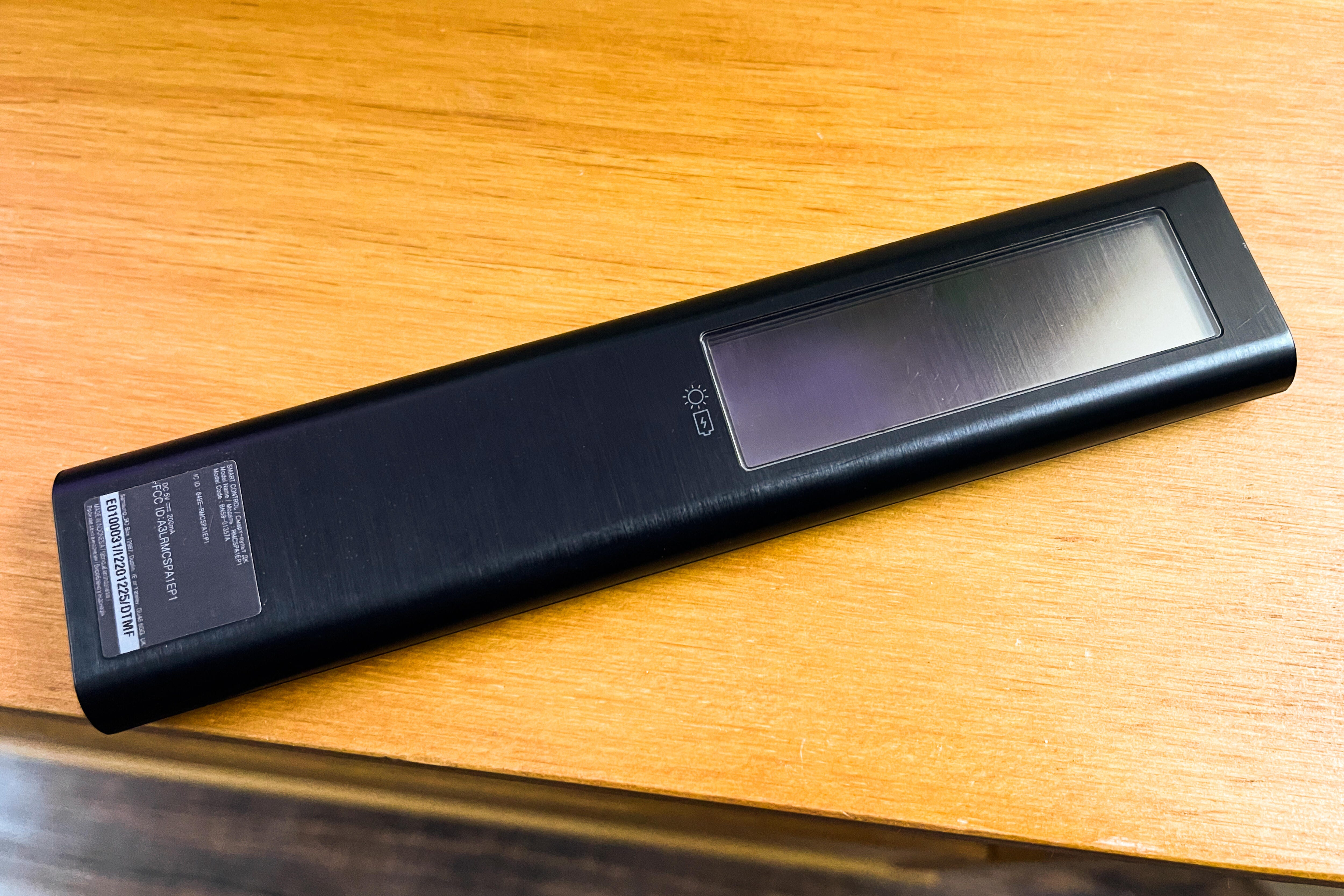
On the back, the remote has a solar panel.
David Katzmaier/CNETAnd yes, the remote has a solar panel on the back. I didn't test Samsung's claim that leaving it under indoor lighting is sufficient to recharge, but I appreciated that it doesn't need batteries. If I owned this TV I'd probably use the USB charging port instead when it ran out of juice.
Samsung's remote is one of my favorites to use, with minimal buttons and just the right feel in-hand. Channel and volume keys click up and down, Ambient mode gets its own button as does the mic for voice and even the Netflix and Amazon app shortcut keys are nicer than on other remotes: They lack garish colors and instead just match the rest of the wand.
Ambient mode is designed to show stuff on the screen when you're not watching TV. It's a cool feature if you don't like the big black rectangle of an inert TV and can display your photos, designer art, the weather, headlines and even adjust backgrounds to match your wall.

The voice assistant can be summoned from the remote or hands-free by saying "Alexa" or (if you prefer, for some reason) "Hi, Bixby."
David Katzmaier/CNETChoice of voice assistant, optional webcam
Voice command is built-in and you can choose between Amazon Alexa, Google Assistant or Samsung's homebrew Bixby. Whichever one you choose will be available when you press the mic button on the clicker. With Amazon and Bixby (but not Google) you also have the option of simply saying "Alexa" or "Hi, Bixby" wake words, allowing you to issue commands hands-free and unlike last year the mic is located in the TV itself, not the remote. And like most TVs, you can also pair the QN90A with separate Alexa or Google speakers.
Samsung's health app debuted on its TVs in 2020 and this year it's expanding to offer guided personal training. Plug in an optional webcam (Samsung has a list of recommended cameras, all by Logitech) and the app will track your exercises and give you coaching complete with celebrity personal trainers like Jillian Michaels.
You can also use that webcam for video chat with the Google Duo app, which allows up to 12 others to join the chat. And if you don't have a camera plugged in you can screen mirror Duo on your phone to the TV and use its camera. It's not Google's more popular Meet software, but at least it's web chat on the big screen.
I didn't test the webcam features for this review, but I did test drive the personal trainer earlier this year -- and worked up a sweat, as seen in the video below.
Beyond voice and the webcam, Samsung's on-screen smart TV system is excellent, with quick responses and plenty of apps -- I'd take it over LG or Vizio's systems. I still like Roku and Android/Google TV (found on Sony TVs) better overall, however, because they have even more apps. Just like most TVs now (including Roku), Samsung has the Apple TV app and works with Apple's AirPlay system.

Samsung's home page pops up from the bottom so it doesn't obscure what you're watching.
David Katzmaier/CNET(More) features galore
Samsung sells a few higher-end TVs, including 8K resolution models as well as super-expensive Micro-LED TVs, but the Q90A is still bursting with image quality extras. The most important is that Neo QLED, mini-LED powered backlight with full-array local dimming. Local dimming improves LCD image quality by making certain areas of the picture dimmer or brighter in reaction to what's on the screen, which significantly boosts contrast. Judging from Samsung's obscure "quantum HDR" spec the QN90A has more dimming zones and brighter images than the step-down Q85A, and fewer zones than the 8K models, but Samsung doesn't say exactly how many zones (or how bright).
Key features
| Display technology | LED LCD |
|---|---|
| LED backlight | Full array with local dimming |
| Resolution | 4K |
| HDR compatible | HDR10, HDR10+ |
| Smart TV | Tizen |
| Remote | Standard voice |
Like all of Samsung QLED TVs, as well as most higher-end TVs from Vizio and TCL, the QN90A's LCD panel is augmented by a layer of quantum dots -- microscopic nanocrystals that glow a specific wavelength (i.e. color) when given energy. The effect is better brightness and color compared to non-QD-equipped TVs. The QN90A uses a true 120Hz panel, which improves the TVs' motion performance.
The set supports high dynamic range content in the HDR10 and the HDR10 Plus formats. It lacks the Dolby Vision HDR support found on most competitors' HDR TVs. I've seen no evidence that one HDR format is inherently "better" than the other, so I definitely don't consider the lack of Dolby Vision a deal-breaker on this TV -- it performs like a champ without that format.
Gaming features are one of the QN90A's strong points. All four of its HDMI inputs are compatible with variable refresh rate, including AMD's FreeSync and standard VRR formats, as well as ALLM (aka Auto Game Mode), which lets it automatically switch to game mode to reduce input lag when it detects you're playing a game. Only Input 3 handles eARC.
Input 4, which is conveniently marked with a little game controller icon, also accepts 4K/120Hz with and without HDR. None of the other inputs handle 4K/120, which should only be a problem if you have multiple devices that output it -- like a PlayStation 5 and an Xbox Series X (you know who you are...), or one of those consoles and a high-end graphics card. It's worth noting that every input on LG's recent OLED TVs supports 4K/120.
Read more: Best TV for PS5 and Xbox Series X, Series S in 2021
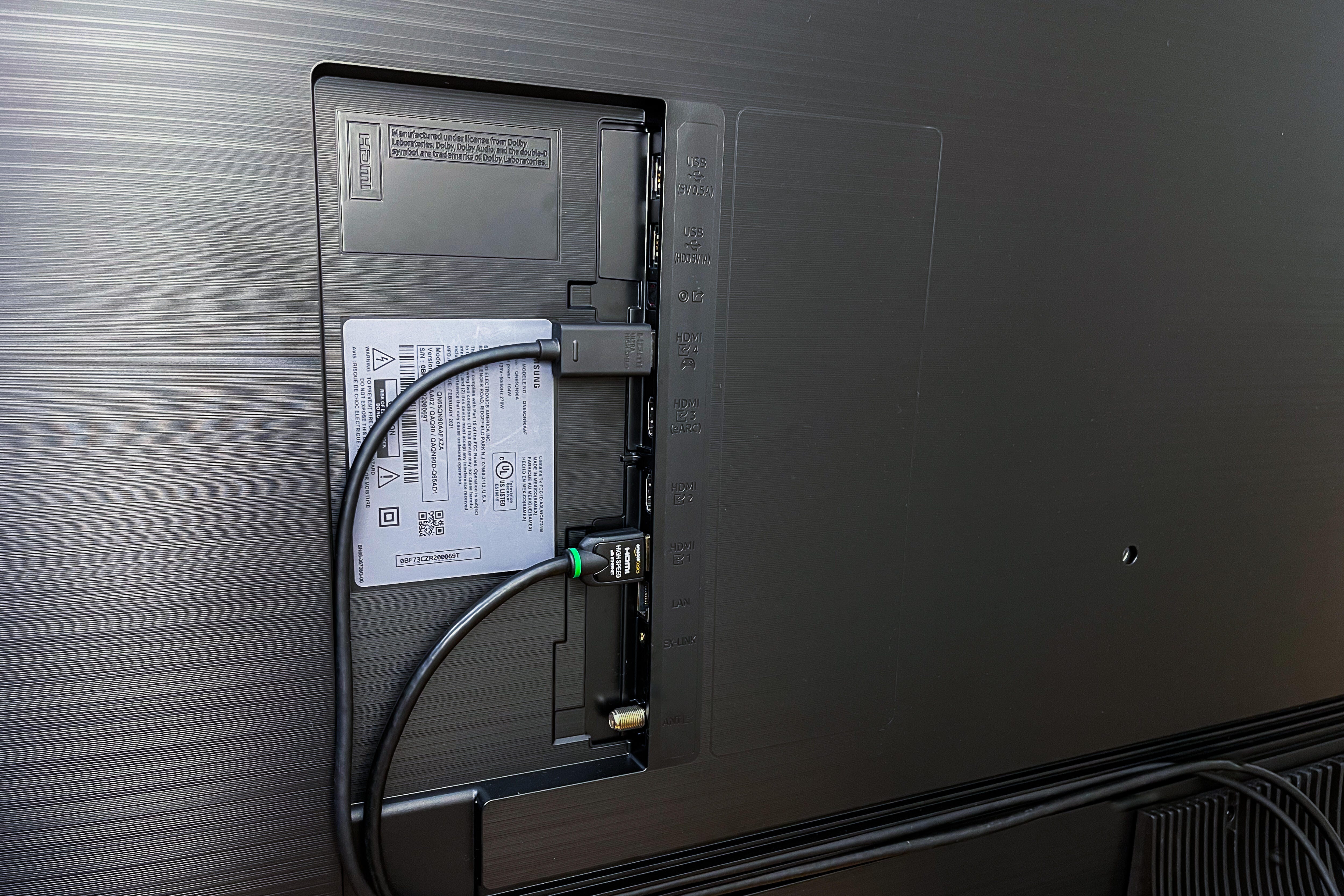
The top input, Input 4, has the best specs for gaming.
David Katzmaier/CNET- 4x HDMI inputs
- 2x USB ports
- Ethernet (LAN) port
- Optical digital audio output
- RF (antenna) input
- Remote (RS-232) port (EX-LINK)
The list is mostly solid, unless you happen to own a legacy device that requires analog video (component or composite) or audio. Like many new high-end TVs the QN90A lacks analog inputs entirely, audio or video. On the flipside, it is one of the few TVs with a built-in ATSC 3.0 tuner for Next-Gen TV signals.
Picture quality comparisons
The Samsung QN90A has the best picture of any non-OLED TV I've tested and the best bright-room picture full stop. It's exceedingly bright, yet able to deliver deep, inky black levels with minimal blooming even with the most challenging HDR material. It can't beat the contrast and theatricality of competing high-end OLED models like the LG G1 overall, however, and also falls a bit short in uniformity and off-angle performance. If I had to choose one TV to watch every day it would still be an OLED, but it's very close.
Dim lighting: Watching the basic, SDR 1080p version of The Desolation of Smaug Blu-ray in a dark room, the Samsung QN90A came as close to the LG OLED as I've ever seen from an LCD-based TV. Its black levels were essentially perfect -- or close enough that I couldn't visually distinguish them from the OLED -- in most scenes, even in the letterbox bars and shadows. When Gandalf meets Thorin during the prologue at the Prancing Pony, for example, it was really difficult to tell the two apart, while the black levels on the Vizio, in comparison, were lighter and created a flatter, less three-dimensional look. In rare cases, for example the titles against a black screen, the Samsung's black levels did look lighter (worse) than the LG's.
Details in shadows were excellent on all three TVs, although again the Vizio looked a bit less realistic because of its slightly lighter overall black levels. Watching SDR I didn't see any evidence of blooming or stray illumination on either the Samsung or the Vizio with normal video. The exceptions were graphical elements, for example the play/pause icons my Blu-ray player put in the upper left created a faint halo against the letterbox bar on the Samsung.
Bright lighting: The QN90A is exceedingly bright, especially compared to OLED models. The Vizio PX measured a bit brighter overall and also maintained peak brightness in its brightest setting better.
Light output in nits
| TV | Brightest (SDR) | Accurate color (SDR) | Brightest (HDR) | Accurate color (HDR) |
|---|---|---|---|---|
| Vizio P65QX-H1 | 2,017 | 1,287 | 2,780 | 2,064 |
| Samsung QN65QN90A | 1,622 | 1,283 | 2,596 | 1,597 |
| TCL 65R635 | 1,114 | 792 | 1,292 | 1,102 |
| Sony XBR-65X900H | 841 | 673 | 989 | 795 |
| Samsung QN65Q80T | 664 | 503 | 1,243 | 672 |
| LG OLED65G1 | 377 | 334 | 769 | 763 |
As usual the Samsung's brightest setting, Dynamic, was woefully inaccurate. For the Accurate measurements in SDR I used the Natural picture mode in combination with the Warm color temperature setting (the default temperature for Natural is quite blue). If you want an even more-accurate bright-room image you can choose Movie or Filmmaker mode and turn the Brightness control up to 50 (the max), which measured 620 nits. In any case I prefer Vizio's approach of a dedicated, accurate bright-room picture mode.
The QN90A maintained steady HDR light output over time in Movie and Filmmaker modes, but in Dynamic mode with both HDR and SDR it fluctuated significantly, starting out at around 2500 nits but falling almost immediately to around 500 -- a massive, five-fold decrease. I've seen that behaviour on past Samsung TVs as well and it seems designed to achieve prominence in charts like the one you see above. It's worth noting that the Vizio PX, among other non-Samsung TV's I've tested, maintained their brightest images much more steadily over time, without drastic fluctuations. This issue in Dynamic mode isn't a huge deal for me, however, because I don't recommend using that mode anyway.
Samsung's light-rejecting screen is the best in the business, maintaining contrast and punch in bright lighting, and reducing reflections, better than the Vizio and the LG. The screen, combined with the QN90A's prodigious light output, make it the best TV I've ever tested for bright rooms.
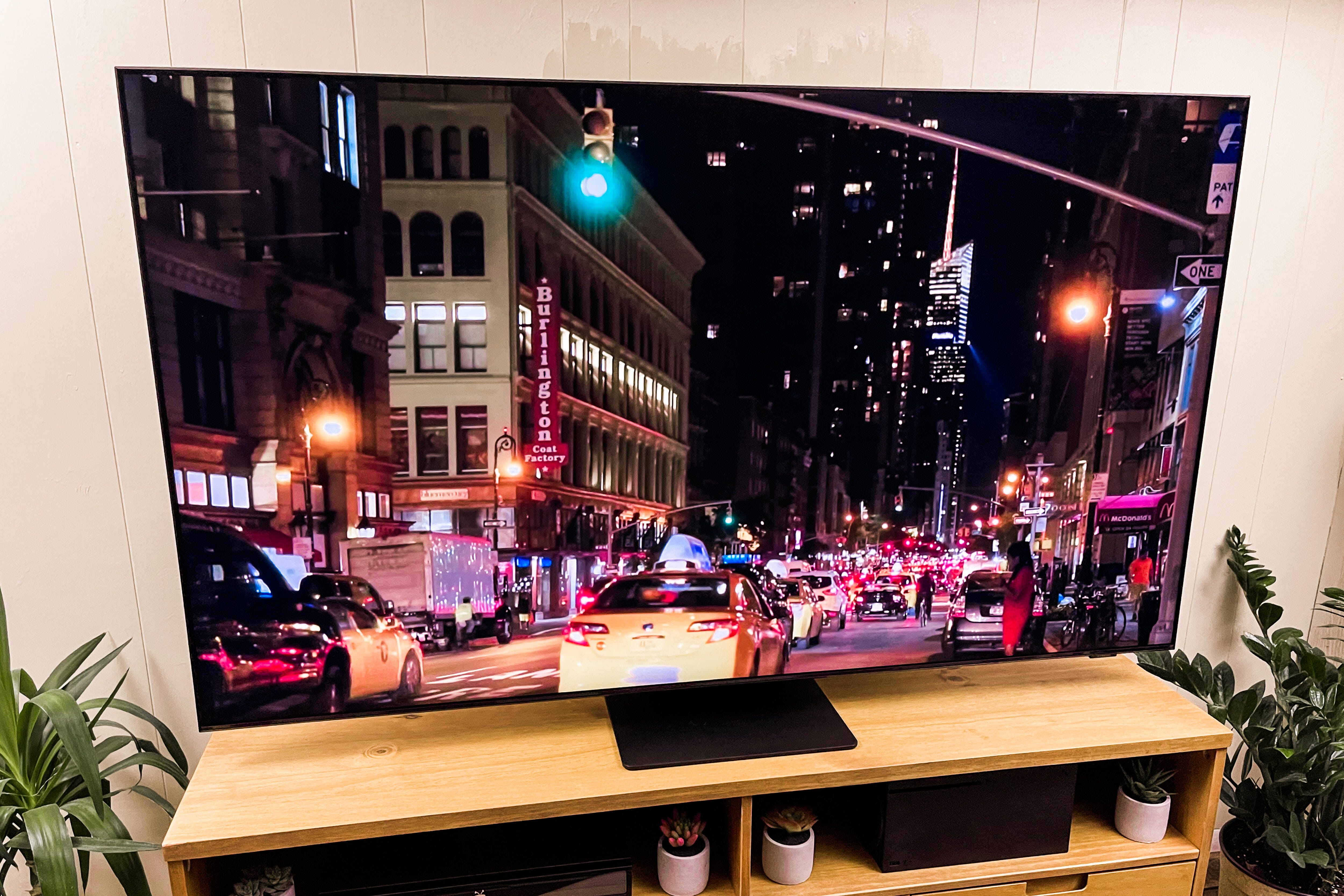
The Samsung's screen was excellent at rejecting reflections.
David Katzmaier/CNETColor accuracy: All three high-end TVs measured exceedingly well for color both before and especially after calibration, and watching The Hobbit Blu-ray I couldn't really pick a winner. Colors from Galadriel's delicate skin tone to the green and brown of Mirkwood to the gray of Gandalf's cloak looked true. The LG did show a slight advantage in near-black grayscale, where the Samsung tended slightly blue, but the difference was subtle.
Video processing: As usual the Samsung aced my tests in this category, delivering true 1080p/24 film cadence with film-based sources and plenty of motion resolution (1,000 lines) with video-based sources. The TV achieved both results with a Picture Clarity setting of Custom with Blur Reduction at 10 and Judder Reduction at 0, so if I had this TV I'd "set it and forget it" right there. Note that Filmmaker Mode's default setting is to turn Picture Clarity off, which results in less motion resolution, but you can adjust it to taste.
You can also add more smoothing or soap opera effect by increasing Judder Reduction or choosing Auto instead of Custom. Meanwhile the LED Clear Motion option makes motion even sharper with the help of black frame insertion, at the expense of flicker and a dimmer image.
Uniformity: The QN90A's screen was worse than the Vizio and LG at maintaining an even light spread everywhere, with some slight variations visible in full-screen test patterns, particularly along the edges and in the upper middle. In moving test patterns the QN90A showed a slightly more noticeable dirty screen effect as a result, but it was still quite mild.
From off-angle the Samsung was slightly better at preserving contrast and color than the Vizio, even when the latter's "enhanced viewing angle" mode was engaged, but the differences were minor and both, as usual, significantly trailed the off-angle fidelity of the OLED.
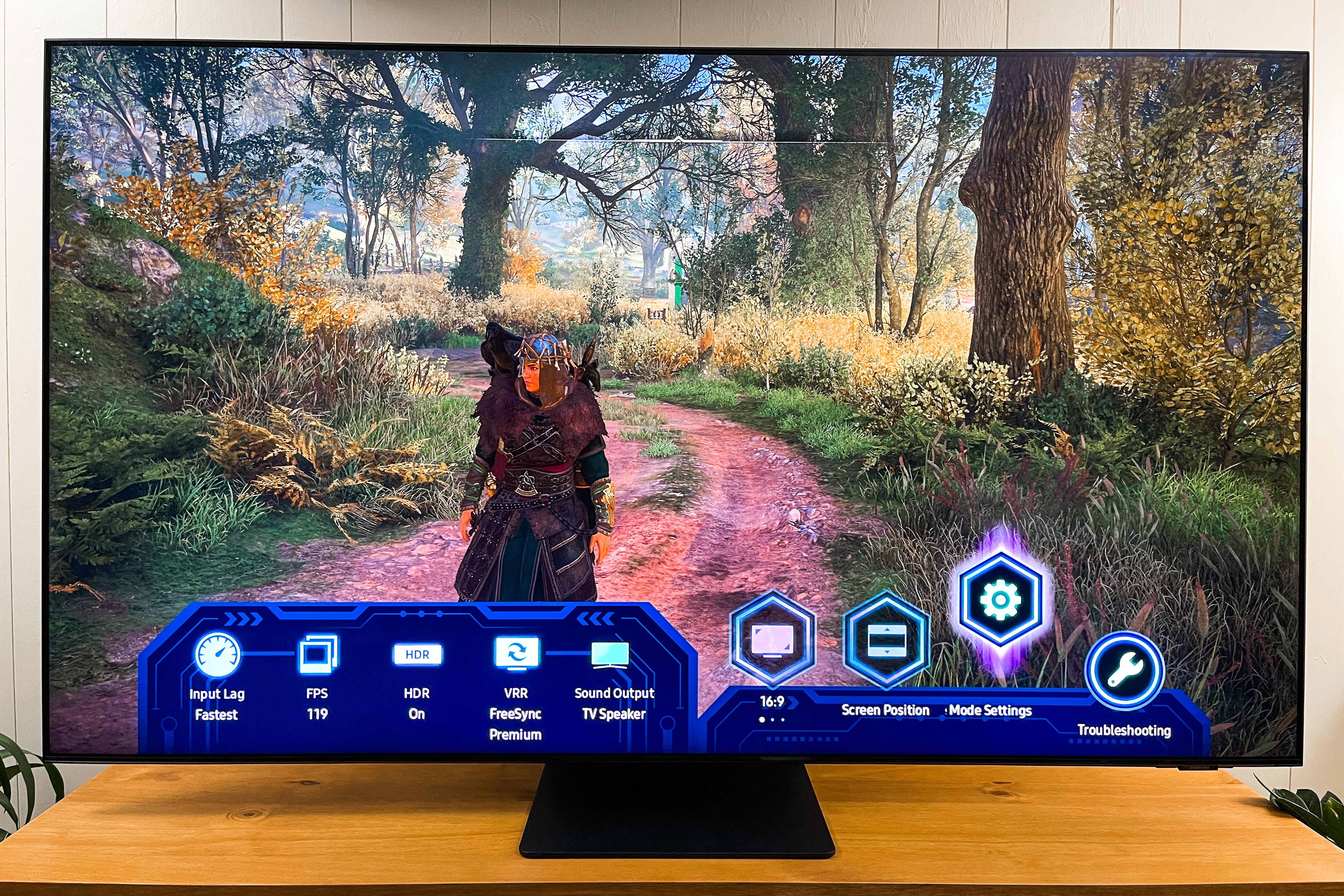
The Game Bar pop-up provides instant access to gaming info.
David Katzmaier/CNETGaming: The QN90A is a gaming powerhouse. When I first plugged in my Xbox Series X the TV automatically detected it, switched to its input and implemented Game Mode, complete with a pop-up at the bottom that Samsung calls the Game Bar -- long-pressing play/pause on the remote calls it up at any time. The Bar's left side consists of a status display listing Input Lag, FPS (frames per second), HDR, VRR and sound output, while controls on the right provides a shortcut to game settings as well as aspect ratio and screen position (the latter only active with PC sources, which I didn't test).
Samsung continues its tradition of excellent input lag in game mode with a score of just over 10 milliseconds with both 1080p and 4K HDR sources -- the best I've measured. You can choose to engage smoothing, aka Auto Motion Plus, in game mode but doing so raises input lag as high as 26ms, depending on what level you choose. I'd leave it turned off.
Comparing Assassin's Creed: Valhalla, the Samsung looked excellent, brighter than the LG (as expected) and the Vizio, which looked duller and more washed out. I still preferred the LG's look overall with this theatrical game, however, because it preserved more contrast especially at night and underground while still allowing me to see into the shadows well enough. Samsung does offer a special shadow detail control called "Dynamic Black Equalizer" that lets you expose/wash out shadows even more, but it doesn't have specialized gaming picture modes like LG. Whether you miss them depends on how much you want to tweak the picture -- I personally like having the option.
HDR and 4K video: Like all high-end LCDs the QN90A can get brighter than even the brightest OLED TV, but it does a better job of delivering deep black levels and minimal blooming than any non-OLED TV I've tested.
I started my HDR comparison with the montage from the Spears and Munsil HDR Benchmark and the Samsung QN90A's brightness advantage over the LG G1 was immediately apparent. The Q90A measures twice as bright as the G1 and in my side-by-side comparison it looked even brighter, especially in areas like the snow-capped mountains, skies and clouds. That's because OLED's brightness falls rapidly as more of the screen is occupied by bright objects, while LCD's brightness varies less by image area. The Samsung also looked brighter and more impactful in highlights such as the middle of a ferris wheel at night, of course, but in larger areas it was more apparent.
Meanwhile the LCD-based Vizio, despite its superior measurements, looked dimmer than the Samsung, albeit still a bit brighter than the OLED. Spot measurements confirmed those impressions. The sunset at 2:08, for example, measured 427, 522 and 887 nits on the LG, Vizio and Samsung, respectively. For their part colors were superb on the Samsung, saturated yet accurate in areas like the flowers and insects at 3:27, and the extra brightness lent additional pop.
As usual the OLED maintained perfect black levels while the Samsung and Vizio looked very slightly lighter, but in many scenes -- the objects against black backgrounds, for example -- the Samsung was so good that picking out the OLED was difficult.
I did see a bit more blooming than with SDR, as expected, but again it was very well-controlled on the Samsung. In the dipper at 2:49, for example, the black background around the honey betrayed a slight glow, as did the pause icon on my Blu-ray player (again) -- but both were less-noticeable than on the Vizio and just a bit worse than the blooming-free OLED. Mixed scenes, for example the nighttime cityscape at 4:26, did show more of an advantage for OLED, which was able to keep the dark areas darker for more pop, but the Samsung still looked excellent.
I didn't notice any banding or similar artifacts in the LG or the Samsung, both of which looked very clean, but there was some on the Vizio. It popped up in the sky during the initial fade up from black, for example, where bands of varying brightness appeared where there should be a smooth transition. The Samsung did show minor brightness variations caused by the backlight structure (particularly near the edges), like the blue sky above the satellite dish at 5:29, but they were quite subtle.
I also checked out the montage at 4,000 nits and the Samsung lagged behind the LG. There was less detail in bright areas like the snowy pasture and the cliffside, which made the QN90A appear somewhat flatter despite its superior brightness. It's not a huge disadvantage however since 4,000 nit content is relatively rare.
When I switched from Spears and Munsil to The Desolation of Smaug, the tables turned and the LG looked better overall than the Samsung. During the challenging evening Bree scene in the prologue, for example, the LG's shadows appeared just a bit deeper and its highlights, like the lamps and torches, looked slightly brighter, for an overall high-contrast look that the Samsung -- while excellent -- couldn't quite match. Both outclassed the Vizio, however, whose black levels were lighter leading to a more washed-out look. Moving to a brighter scene, inside Beorn's house (9:16), the G1 again looked a tick more realistic and rich compared to the QN90A.
As with Spears and Munsil, large-area brightness scenes favored the Samsung. As the orcs pursue the dwarves across a bright field at 7:50, for example, both LCDs (and especially the Samsung) appeared more brilliant and impressive. But as in most theatrical films, scenes in The Hobbit tended toward more mixed and even darker scenes, where the OLED held a slight contrast advantage over the Samsung.

Picture settings, HDR notes and charts
CNET is no longer publishing advanced picture settings for any TVs we review. Instead, we'll give more general recommendations to get the best picture without listing the detailed white balance or color management system (CMS) settings we may have used to calibrate the TV. As always, the settings provided are a guidepost and if you want the most accurate picture you should get a professional calibration.
Before my calibration for this review, Samsung's Movie and Filmmaker presets were the most accurate, excellent in terms of grayscale and gamma with just a slight reddish cast (but still within my error target of delta 3). Note that Filmmaker Mode because it disables all of the Picture Clarity settings, including motion enhancement (see the review for details) -- although it does engage ambient light sensing by default, which I turned off.
For calibration I tweaked the two-point grayscale to remove the red cast, reduced light output to my target of 137 nits and changed gamma to target 2.2, but otherwise I left well enough alone. The grayscale and color were already so accurate on my Samsung-provided review sample that I didn't need to touch the multipoint system or the color management system.
Picture Mode: Movie Mode
Picture Size settings: 16:9 Standard (Fit to Screen: On)
Expert settings:
- Brightness: 13
- Contrast: 43
- Sharpness: 0
- Color: 25
- Tint (G/R): 0
- Apply Picture Settings: All Sources
- Picture Clarity Settings: Custom (Blur Red. 10, Judder Red. 0, LED Clear Motion: Off, Noise Red. Off)
- Local Dimming: Standard
- Contrast Enhancer: Off
- Film Mode: Off [grayed out; when active Auto 1 is usually best]
- Color Tone: Warm 2
- White Balance: [No adjustments, see above]
- Gamma: 2.2
- Shadow Detail: 0
- RGB Only mode: Off
- Color Space Settings: Auto
HDR Notes: As with SDR, Samsung's Movie and Filmmaker Modes were the most-accurate for HDR sources. Both were significantly more-accurate than Dynamic, the brightest mode, and still quite bright at more than 1500 nits. The QN90A followed the EOTF closely in both modes but was a bit better in Filmmaker, so that's what I'd choose for the most accurate HDR. Its advanced color measurements were superb, with Color Checker and the more stringent ColorMatch HDR both well under a delta error of 3. The LG G1 OLED was worse on both counts. In terms of gamut coverage the QLED lagged the OLED by a couple percentage points, but it was still above my 95% threshold -- and much better than the Q80 from 2020.
Geek Box
| Test | Result | Score |
|---|---|---|
| Black luminance (0%) | 0.001 | Good |
| Peak white luminance (SDR) | 1622 | Good |
| Avg. gamma (10-100%) | 2.22 | Good |
| Avg. grayscale error (10-100%) | 0.38 | Good |
| Dark gray error (30%) | 0.15 | Good |
| Bright gray error (80%) | 0.41 | Good |
| Avg. color checker error | 1.20 | Good |
| Avg. saturation sweeps error | 1.42 | Good |
| Avg. color error | 1.56 | Good |
| Red error | 1.94 | Good |
| Green error | 0.54 | Good |
| Blue error | 2.22 | Good |
| Cyan error | 0.99 | Good |
| Magenta error | 2.43 | Good |
| Yellow error | 1.22 | Good |
| 1080p/24 Cadence (IAL) | Pass | Good |
| Motion resolution (max) | 1200 | Good |
| Motion resolution (dejudder off) | 1000 | Good |
| Input lag (Game mode) | 10.27 | Good |
| HDR10 | ||
| Black luminance (0%) | 0.002 | Good |
| Peak white luminance (10% win) | 2596 | Good |
| Gamut % UHDA/P3 (CIE 1976) | 95.52 | Good |
| ColorMatch HDR error | 1.90 | Good |
| Avg. color checker error | 2.19 | Good |
| Input lag (Game mode, 4K HDR) | 10.20 | Good |
Samsung QN65QN90A by David Katzmaier on Scribd
Portrait Displays Calman calibration software was used in this review.
The Link LonkMay 29, 2021 at 06:00PM
https://ift.tt/3wIsAcU
Samsung QN90A series (2021) QLED TV review: Closer than ever to OLED - CNET
https://ift.tt/31VSHRH
Samsung
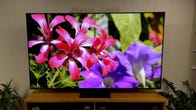
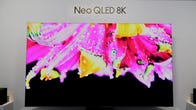
No comments:
Post a Comment